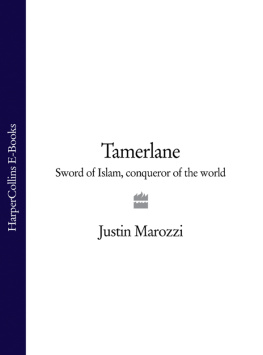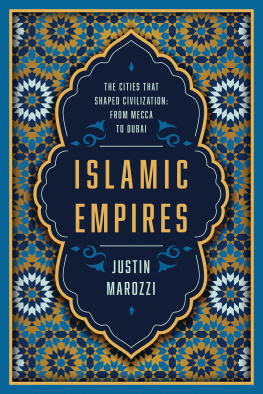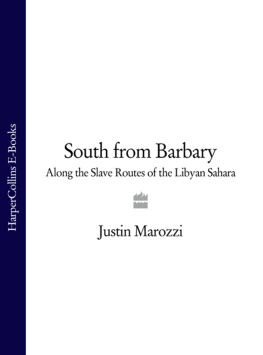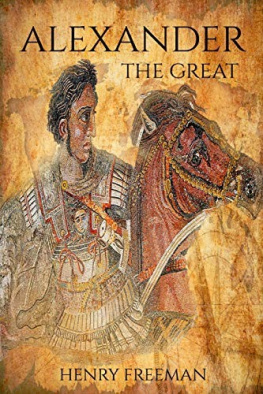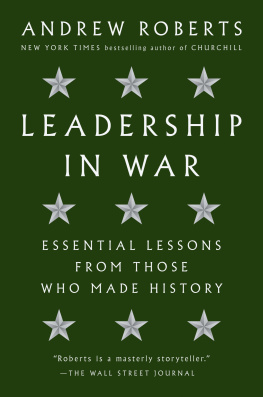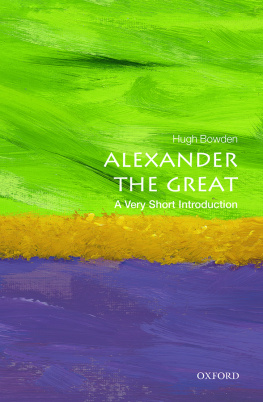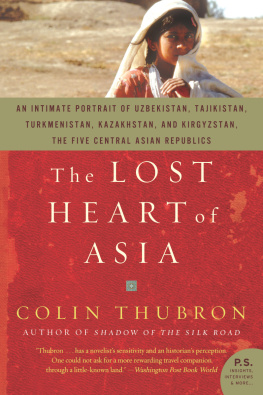The worlds most famous Mongol conqueror is a case in point. Take your pick from Genghis Khan, Chinghiz Khan, Chingiz Khan, or even Chinggis Khan. The lands he bequeathed his son became the Juchid empire. Others call it Jochid. Still others prefer Dj id.
Scholars invariably favour the more obscure spellings, but I have tried to use terms familiar to the general reader. Central Asian names are complicated enough, it seems to me, without making things more difficult.
Tamerlane was in fact Temur (or Timur). The longer name by which we in the West know him was a corruption of Temur the Lame. He was a Chaghatay (or aghatay if you like your diacritic symbols), or a Turkicised Mongol, or a Turk; but I have followed a long line of Europeans who describe him as a Tatar.
Consistency in these matters is as elusive as peace and tranquillity were to Temur. As T.E. Lawrence so emphatically expressed it in Seven Pillars of Wisdom after a plea for clarity from his editor: There are some scientific systems of transliteration, helpful to people who know enough Arabic not to need helping, but a wash-out for the world. I spell my names anyhow, to show what rot the systems are. In a less brazen way I have followed his example.
1
Beginnings on the Steppe
13361370
Tamerlane, the Lord of the Conjunctions, was the greatest Asiatic conqueror known in history. The son of a petty chieftain, he was not only the bravest of the brave, but also profoundly sagacious, generous, experienced, and persevering; and the combination of these qualities made him an unsurpassed leader of men and a very god of war adored by all ranks The object of Tamerlane was glory, and, as in the case of all conquerors ancient or modern, his career was attended by terrible bloodshed. He sometimes ordered massacres by way of retribution or from policy, but there were few that had their origin in pure savagery.
LIEUT. COL. P.M. SYKES, A History of Persia
At around 10 oclock on the morning of 28 July 1402, from a patch of raised ground high above the valley, the elderly emperor surveyed his army. It was a vast body of men, spreading over the Chibukabad plain, north-east of Ankara, like a dark and terrible stain. Through the glinting sunlight the ordered lines of mounted archers stretched before him until they were lost in the shimmering blaze, each man waiting for the signal to join battle. There were two hundred thousand professional soldiers drawn from the farthest reaches of his empire, from Armenia to Afghanistan, Samarkand to Siberia. Their confidence was high, their discipline forged in the fire of many battles. They had never known defeat.
For the past thirty years these men and their sons and fathers had thundered through Asia. Through deserts, steppes and mountains the storm had raged, unleashing desolation on a fearful scale. One by one, the great cities of the East had fallen. Antioch and Aleppo, Balkh and Baghdad, Damascus and Delhi, Herat, Kabul, Shiraz and Isfahan had been left in flaming ruins. All had crumpled before the irresistible Tatar hordes. They had killed, raped, plundered and burnt their way through the continent, marking each triumph with their dreadful trophies. On every battlefield they left soaring towers and bloody pyramids built from the skulls of their decapitated victims, deadly warnings to anyone who dared oppose them.
Now, as the soldiers stared up at the distant silhouette of a man on horseback, framed against the heavens, they steeled themselves for another victory. Truly their emperor had earned his magnificent titles. Lord of the Fortunate Conjunction (of the Planets, a reference to the auspicious position of the stars at his birth); Conqueror of the World; Emperor of the Age; Unconquered Lord of the Seven Climes. But one name suited him above all others: Temur, Scourge of God.
On his vantage point beneath the smouldering midsummer sky, the emperor felt no disquiet. Moments away from the most important battle of his life, he felt nothing but the unshakeable faith in his destiny that had served him so well. Dismounting from his stallion, he knelt to offer up his customary prayers to the creator of the universe, humbly prostrating himself on the scorched earth, dedicating his victories to Allah and asking Him to continue bestowing divine favour on His servant. Then, with all the saddle-stiffness of his sixty-six years he rose to his feet and looked out over the field of battle, where the future of his dynasty lay with his beloved sons and grandsons.
The left wing was commanded by his son Prince Shahrukh and grandson Khalil Sultan. Its advance guard was under another grandson, Sultan Husayn. Temurs third son Prince Miranshah led the right wing, his own son Abubakr at the head of the vanguard. But it was the main body of the army, a glittering kaleidoscope of men under the command of his grandson and heir Prince Mohammed Sultan, on which the emperors clouded eyes may have lingered longest. From the midst of these men rose Temurs crimson standard, a horse-tail surmounted by a golden crescent. Newly arrived from the imperial capital of Samarkand, unlike their battle-weary brothers in arms, these troops were splendidly attired, each detachment resplendent in its own colour. There were soldiers carrying crimson ensigns with crimson shields and saddles. Others were clad from head to toe in yellow, violet or white, with matching lances, quivers, cuirasses and clubs. In front of them stood a line of thirty exquisitely equipped purveyors of destruction, war elephants seized after the sacking of Delhi in 1398. On their backs, guarded behind wooden castles, stood bodies of archers and flame-throwers.
The Tatar army was, wrote the fifteenth-century Syrian chronicler Ibn Arabshah, a devastating sight. Wild beasts seemed collected and scattered over the earth and stars dispersed, when his army flowed hither and thither, and mountains to walk, when it moved, and tombs to be overturned, when it marched, and the earth seemed shaken by violent movement.
Staring at them across the sweltering plain were the ranks of Temurs mightiest enemy. The Ottoman Sultan Bayazid I, the self-styled Sword Arm of Islam, had put a similar number of troops into the field. There were twenty thousand Serbian cavalry in full armour, mounted Sipahis, irregular cavalry and infantry from the provinces of Asia Minor. Bayazid himself commanded the centre at the head of five thousand Janissaries the makings of a regular infantry supported by three of his sons, the princes Musa, Isa and Mustapha. The right wing was led by the sultans Christian brother-in-law, Lazarovic of Serbia, the left by another of his sons, Prince Sulayman Chelebi. These men, victors of the last Crusade at Nicopolis in 1396, where they had snuffed out the flame of European chivalry, were thirsty, exhausted and dispirited after a series of forced marches. Even before battle commenced their morale had been shattered by Temurs brilliant tactical manoeuvrings. Only a week earlier they had occupied the higher ground on which their adversarys army now stood. Feigning flight, the Tatar had outmanoeuvred them, diverted and poisoned their water supply, doubled back, plundered their undefended camp and taken their position.
All was still on both sides. A ripple stirred through Temurs lines of cavalry as the horses sensed a charge. Then, slicing through the silence, came the heavy rumble of the great kettle-drums, joined by cymbals and trumpets, the signal for battle. Now the valley echoed to the thundering of horses hooves, the swoosh of arrows and the clash of metal upon metal. From the first blows struck the fighting was ferocious. Charging across the plain came the formidable Serbian cavalry, bright globules of armour amid the choking wreaths of dust stirred up by their mounts. Under pressure, the Tatar left flank retreated, defending itself with volley after volley of arrows and flames of naphtha. On the right wing Abubakrs forces, advancing against Prince Chelebis left wing under cover of a cloud of arrows, fought like lions and finally broke through their enemys ranks. Bayazids Tatar cavalry chose this moment to switch sides, turning suddenly against Chelebis Macedonians and Turks from the rear. It was a decisive moment which broke the Ottoman attack. Temur, a master of cunning, had engineered the defection of the Tatars in the months before the battle by playing on their sense of tribal loyalty and holding out the prospect of richer plunder. Seeing both the disarray of his own forces who were being overwhelmed by the Tatars, and the confusion of the Ottoman right wing, in desperate retreat from the mounted cavalry of Temurs grandson Sultan Husayn, Chelebi judged the battle lost and fled the field with the remainder of his men.

